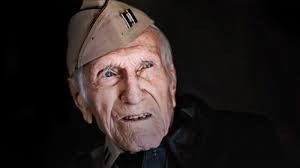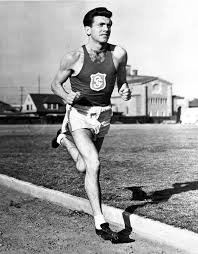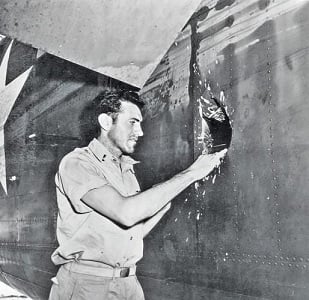 |
| (https://www.youtube.com/watch?v=U9DCn1oW9Bs) |
Imagine becoming an Olympic runner and a war breaks out, only to find yourself imprisoned in a Japanese P.O.W. camp. This happened to Louis Zamperini. Zamperini was born on January 26, 1917, he moved from Olean, NY to Torrance, CA when he was two years old. Zamperini went from committing small crimes, to an Olympic runner, then a dutiful war hero, and finally an inspirational speaker. These accomplishments made Zamperini widely known and glorified. However, it's Zamperini's resilient and selfless attitude that made him a true hero.
Zamperini was born into an Italian family with one sibling, eventually having a total of 3 siblings. Zamperini, a troubled student, was on the brink of going to jail, until his older brother Pete forced him to run to keep him out of trouble (Andrews). This led Zamperini to become a high school track star, eventually breaking the record for the fastest mile time while in high school in 1936 (Biography.com Editors). Later that year Zamperini competed in the 1936 Berlin Olympics; despite coming in 8th place, Zamperini set a new record for fastest final lap in the event's history (Andrews). Zamperini attended college at the University of Southern California and continued to compete on the track.
 |
| (https://www.wsj.com/articles/los-angeles-home-of-unbroken-hero-louis-zamperini-is-listing-for-1-9995) |
In late 1941 Zamperini decided he wanted to join the army and serve his country. He served as a B-24 bomber. Zamperini and his crew were shot down on one occasion, and plummeted into the Pacific Ocean. Zamperini and two other soldiers were stranded on a life raft for 47 days, only drinking rain water and catching birds that landed on the raft (Andrew). Zamperini and the other crewmate were found by a Japanese destroyer and taken to a P.O.W. camp. Zamperini served 2 years under a cruel P.O.W. leader Mutsuhiro Watanabe, nicknamed "Bird" (Chitwood). While in the camp Zamperini faced immense labor and starvation almost to the point of death. Zamperini was freed from the camp after two years, when the U.S. dropped the first bomb on Hiroshima (Chitwood). When Zamperini was sent home after the war ended he weighed 85 pounds and had nightmares for 4 years. Zamperini was planning his revenge and wanted to kill "Bird". Instead Zamperini found God and forgave "Bird," which solved his nightmares. Zamperini wrote books about his life during the war; he also had a book written about him which was eventually made into a movie. Zamperini was an inspirational public speaker and would visit soldiers to remind them how important their training is. Zamperini lived a long and full life when he died at the age of 97 on the 2nd of July, 2014 (Andrews).
Zamperini's resiliency under drastic conditions is one of his most prevalent heroic traits. Zamperini left his career as an Olympic runner to join the air force, later getting shot down and forced to survive on a life raft. " On May 27, 1943, while flying a search-and-rescue mission, Zamperini's B-24 Liberator, the Green Hornet, suffered a mechanical problem and crashed into the sea. Zamperini endured hunger and thirst, sharks, storms, and being shot at by Japanese planes" ("Louis Zamperini" Newsmakers). Zamperini was shot at by Japanese fighter planes, attacked by sharks, fought off insanity, and overcame starvation while adrift at sea for 47 days. Zamperini resisted against dire situations and overcame many life or death choices that most others would not be capable of making. These choices became clear do to the mindset he gained pushing himself to become an Olympic runner from a potential convict. Zamperini didn't survive from luck, he had to conquer his inner strength to get passed the obstacles thrown at him which proved to make him a resilient man. Zamperini was captured by the Japanese and was sent to a P.O.W. camp being subjected to torture and mass labor. "It was Sergeant Mutsuhiro Watanabe, who tortured Zamperini, keeping him on the brink of death. At one point he had to hold a [massive] wooden beam over his head for 37 minutes" ("Louis Zamperini" Encyclopedia). Zamperini had a resilient spirit which allowed him to fight through the torture and resist the savage methods of the Japanese. Zamperini proved to the Japanese that he wouldn't subdue to his torture, which created Zamperini's will to survive causing his true resiliency to be portrayed. Zamperini survived through various torture and 47 days in the pacific, revealing his resiliency, but it was not his only heroic trait.
 |
| (https://www.awesomestories.com/asset/view/Unbroken ()) |
Zamperini's selflessness and dutiful character traits are the more protruding and substantial heroic traits. Zamperini enjoyed his life as an Olympic runner, but when the 1940 Olympic games were canceled he enlisted in the army. "The 1940 Olympic Games might have been his, but they were canceled because of war. Zamperini enlisted in the Army Air Force" ("Louis Zamperini" biography). Zamperini a dedicated citizen of the U.S.A wanted to serve his country in some way, and since the olympic games were canceled he knew he wanted to join the army, to prove his loyalty. Zamperini proves he is one in a billion because he would drop his fame and risk his life for the country, a trait that most do not possess. A couple years after he came back from the War Zamperini thought it was time to give back to the community. "He was also a leader for church programs serving young and older citizens. Recalling his own difficult childhood, Zamperini launched a camp for troubled youths" ("Louis Zamperini" Biography). Zamperini shows he is selflessness by using his own time to give back to the community and assist others. Zamperini wasn't focused on what he was getting out of assisting others, he focused on how he could become more involved with the community. Not many people willingly volunteered at churches or built camps for troubled kids, but he did. Through his actions Zamperini portrayed his heroicness, because true heros are the ones who go out of their way to help others before themselves.
Works cited
Chitwood, Adam. "Louis Zamperini." Louis Zamperini. Unbroken, 25 Feb. 2013. Web.03 Feb. 2017.
<http://www.louiszamperini.net/?page=movie>.
Andrews, Evan. "8 Things You May Not Know About Louis Zamperini." History.com. A&E Television
Networks, 17 Dec. 2014. Web. 03 Feb. 2017.
<http://www.history.com/news/8-things-you-may-not-know-about-louis-zamperini>.
"Louis Zamperini." Encyclopedia of World Biography, vol. 36, Gale, 2016. Biography in
Context, link.galegroup.com/apps/doc/K1631010553/BIC1?u=powa9245&xid=65651243.
Accessed 24 Jan. 2017.
"Louis Zamperini." Gale Biography in Context, Gale, 2014. Biography in Context,
link.galegroup.com/apps/doc/K1650009447/BIC1?u=powa9245&xid=bbbfa43e. Accessed 24 Jan. 2017.
"Louis Zamperini." Newsmakers, vol. 1, Gale, 2016. Biography in
Context, link.galegroup.com/apps/doc/K1618006451/BIC1?u=powa9245&xid=ce0351cb. Accessed 24 Jan. 2017.
Merony, John. "World War 2 Isn't Over." The Atlantic. Atlantic Media Company, 11 Nov. 2014.
Web. 24 Jan. 2017. <http://www.theatlantic.com/politics/archive/2014/11/world-war-ii-isnt-over-talking-to-
Page created on 2/11/2017 12:00:00 AM
Last edited 2/11/2017 12:00:00 AM
